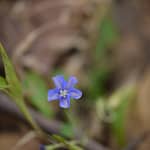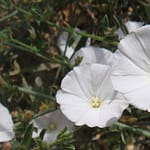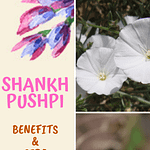
“Shankhpushpam kannezhuthumbol shak unthale ninne orma varum…” If you know this song, you’re probably familiar with the works of the famous Malayali poet Vayalar Ramavarma. Loosely translated, the lyrics pay tribute to a luminescent blue flower with a gorgeous yellow centre – Shankhpushpi. In the song, this beautiful, fragrance-less flower reminds king Dushyanta of the beautiful eyes of Shakunthala. That’s not all. The herb is also revered in Hindu mythology as a “heavenly plant” brought to earth by Guru Shukracharya and is used to pay homage to Lord Shiva and Goddess Durga.
Moving onto the technical details, the Shankhpushpi plant has many names, forms, and applications. Shankhpushpi literally translates to a conch-shaped (Shankh) flower (pushp). Typically found in tropical Asian countries like India and Burma, this herb grows in the wild and goes by the names of Convolvulus Pluricaulis (Botanical name), Butterfly Pea (English name), Vishnukranthi, and Aparajita (Hindi name) among many others.
Shankhpushpi Holistic Uses

All parts of the Shankhpushpi plant (the roots, leaves, and the plant itself) can be used in one form or another. Generally found in white or pink-coloured variations, the flower is adorned with small violet-coloured hair. Additionally, the flower is majorly used as a food colourant in different parts of the world and can be consumed in the syrup or powder form. But perhaps the biggest advantage of this all-purpose plant is that it requires little maintenance. Naturally, this makes it a perfect ancient medicinal plant for farmers to grow and cultivate, well naturally (pun not intended).
Nutritional Information & Dosage: How to Use the Super Powerful Shankhpushpi Herb
Nutritionally, Aparajita plant contains carbohydrate-D glucose, maltose, ramnose, and sucrose. Plus, it’s also rich in glacial acetic acid, sclopoetin, kaemferol, convoline, and B-sito serol. All these nutrients lend it the following medicinal properties:
- Nootropic (google definition: a drug used to enhance memory or other cognitive functions)
- Anti-stress
- Anxiolytic (google definition: a drug used to relieve anxiety)
- Anti-depressant
- Anti-convulsant
- Anti-microbial
- Antipyretic
- Anti-inflammatory
- Analgesic
- Diuretic
- Local anaesthetic
- Anti-diabetic
- Blood platelet aggregation-inhibiting
- Muscle- and min-relaxant
- Anti-hypertensive
General Recommended Dosage: Shankhpushpi Syrup
- Children: 10 ml
- Adults: 20 ml
- Elderly: 10 ml
- Maximum dosage limit: 40 ml per day (across divided doses)
In the paste form, apply 1-2 gm of Shankhpushpi. In the capsule form, consume 1 tablet once or twice a day as prescribed by your doctor.
Note: It is preferable to consume this syrup twice daily in the recommended dose once it is diluted with water. Most importantly, make sure to consult your doctor before you consume it.
Ayurvedic Medicines with Shankhpushpi as one of the Primary Ingredient
- Shankhpushpi Oil: This ayurvedic oil is used to enhance memory and boost intelligence capabilities in children.
- Saraswatha Choornam: This herbal medicine helps treat psychosis, depression, mental fatigue, anaemia, etc.
- Brahmi Vati: This medicine in the tablet form treats depression, anxiety, chronic fever, sleeplessness, and blood pressure issues.
- Manasamitra Vatakam: This 73-ingredient herb – in the tablet form — enhances brain functions and treats speech problems as well as depression.
- Chopchinyadi Churna: This herbal powder treats pain and inflammation caused due to insect bites, gout, and rheumatoid arthritis.
How to Make the “Shankhpushpi Tea:” An Extract of the Beautiful, Purposeful Flower
Studies suggest that consuming this tea lowers blood glucose and insulin levels and promote younger-looking skin. Note that it is slightly cool and bitter in taste while being oily and sticky in texture.
Ingredients:
- Butterfly pea flowers: 6 -7 flowers (dry or fresh)
- Sugar/honey/jaggery (as per preference)
- Few drops of lemon juice
- I cup water
Steps to make it:
- Boil flowers in water for five minutes till it turns a beautiful blue colour.
- Strain the water and add preferred sweetener.
- Add a few drops of fresh lemon juice and you’re done! (the colour of the water will change).
Note: You can also consume this drink cold, simply refrigerate or add ice cubes. Alternatively, you can soak the dried powder overnight and strain it to make a “sharbat” – ideal for the scorching heat during the summers.
Shankhpushpi’s All-Round Benefits
This perennial vine has therapeutic values and doubles up as an effective mood stabilizer, making it perfect for patients suffering from depression. It is also known to cure many sexual disorders like infertility, gonorrhoea, menstrual disorders etc. and is known to benefit the central nervous system.
Expert tip: Consume this herb along with ghee (in the Rasayanam form) for a longer lifespan and a strong nervous system.
Let’s look at its diverse benefits in greater details below:
Brain & Cognitive Functions
Used as a brain tonic, it is known to boost memory power. If taken along with Brahmi, Vishnukranthi helps treat a variety of cognitive problems such as forgetfulness, mental weakness, ADHD, memory loss, dementia, low retention powder, etc. One of the four “Medhya Rasayanas” in Ayurveda, it is known to improve concentration and intelligence levels while stimulating and rejuvenating the mind and treating headaches – ideal for children suffering from exam pressures.
Suggested Remedy: Consume 3-6 grams of Shankhpushpi powder with sugar and milk every morning for enhancing memory. In the case of headaches and migraine, mix 1gm of Shankhpushpi powder with 250 gms of ajwain in warm water for instant relief. Alternatively, Swami Shree Nityanandam suggests you take Shankhpushpi’s juice (extracted from the roots) and apply 4 drops in each nostril for a few days. Additionally, you can use the root’s juice as a paste and apply on your forehead for relief.
Hypertension – High Blood Pressure
The white flower can lower blood pressure whereas the blue flower is known to stimulate respiration.
Sleep Issues
Aparajita contains flavonoids, glycosides, and alkaloids that help soothe the nervous system by bringing relief to mental fatigue and aid in better sleep.
Remedy: To treat insomnia, mix 40-80 gms of Shankhapushpi with 1 glass of milk and a pinch of jeera (Cumin seeds).
Breast Cancer
As per the International Food Research Journal, this plant has anti-cancer properties and has significant effects on breast cancer cells.
Hair Growth
This plant promotes hair growth and is known to thicken hair growth naturally.
Anxiety
It helps treat anxiety and related symptoms such as dizziness, dry mouth, restlessness, palpitation, headache, and sleeplessness.
Diabetes
If you’re looking to address weakness related to diabetes, take 2-4 gms of Shankhpushpi powder along with cow milk, and see the magic unfold.
Respiratory Issues
Vishnukranthi helps treat goitre, cough, and arthritis. Additionally, the leaves help treat asthma and bronchitis. To treat cough, Swami Shree Nityanandam suggests you the plant’s roots, 4-5 peppercorn, 2-3 tulsi leaves and grind all the ingredients in a glass full of water. Boil the mixture until it gets reduced to half the quantity and consume.
Epilepsy
It is extremely useful for epilepsy patients.
Suggested Remedy: Consume 2gms of Shankhpushpi juice along with honey twice a day for immediate relief.
Vomiting
It helps control vomiting.
Suggested Remedy: For stopping vomiting, consume 2 tablespoons of Shankhpushpi juice, mixed with honey and a pinch of pepper.
Anti Ageing
According to Charaka Samhita Chikitsa Sthana, you can apply 2-3 gm of Vishnukranthi paste for anti-ageing benefits such as better skin quality and better complexion.
Natural Detoxifier
It helps treat constipation, improves digestive strength, and removes intestinal worms.
Recurring Fever
Swami Shree Nityanandam suggests you take the Shankhpushpi’s roots, break it into smaller pieces, and take a red dhaga (string) to make a garland (mala). Wear it around your neck. Conversely, you can also consume the root’s juicy extract after boiling it with water to address the recurring fever.
Uterus Issues
For treating diverse types of uterus issues such as uterus prolapse, mix Shankhpushpi’s leaves along with changeri plant (Oxalis corniculata) and boil with water. Add fitakri or alum to it and wash the vulva (yoni) area for best results. For women suffering from excessive discharge during periods, grind the Shankhpuhspi leaves to a paste. Extract the juice and add mishri (sweetener) to it and consume.
Elephant Leg
To treat Elephantiasis, Shree Nityanandam suggests you take the Shankhpushpi’s roots and seeds in equal amounts and grind to a powder. Take one teaspoon of this powder twice a day with warm water for relief.
Fun facts about Shankhapushpi:
- It is used in South East Asia to colour rice.
- In Thailand, it is typically used to add colour to desserts.
- In a joint initiative by Dabur, ICRISAT, and the local Krishi Vigyan Kendra, around 55 villages stretching from Barmer to Jodhpur in India are growing Shankhpushpi as an inter-crop with castor, guar and pearl millet to reap its diverse benefits.
- A study demonstrated that Shankhpushpi had thyroid-suppressing effects in mice with hypothyroidism when administered at 0.4 mg/kg.
Shankapushpi Side-Effects & Precautionary Measures
Common Shankhpushpi side-effects and precautionary measures include:
- If you’re taking it as a brain tonic, be extra careful to consult your doctor and consume it only in optimum amounts.
- Pregnant mothers should avoid consuming this herb in any form. However, lactating mothers can consume it after a doctor’s consultation.
- If you suffer from low blood pressure issues, avoid consuming this herb as it is known to further decrease the blood pressure of the body.
- You can give it to children above 3 years of age.
- If you’re getting treated for hypertension, consult a doctor before ingesting it.
Important: Just to reiterate, please consult your doctor before consuming this herb as a precautionary measure.
Where to Buy Shankpushpi Online?
Generally, the Shankhpushpi price range falls between INR 100 -150. Note that Shankhpushpi is available in the tablet, powder, or syrup form with a number of well-renowned brands such as:
- Shankhpushpi Dabur: Helps treat shivering, memory problems, depression, anxiety, etc.
- Shankhpushpi Baidyanath
All in all, Shankhpushpi can be considered to be a natural promoter of life, intellect, and strength. By extension, this mangala kusum – auspicious flower – caters to the mind, body, and soul. Try this powerhouse of a herb and welcome a healthy lifestyle in style!
Did you find this post useful? Would you like to get back to it later? Save THIS PIN below to your Pinterest Ayurveda or Herbs board!

